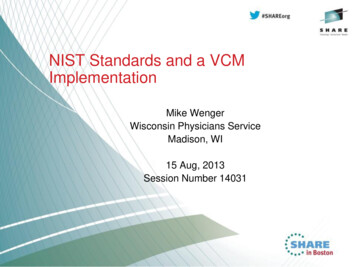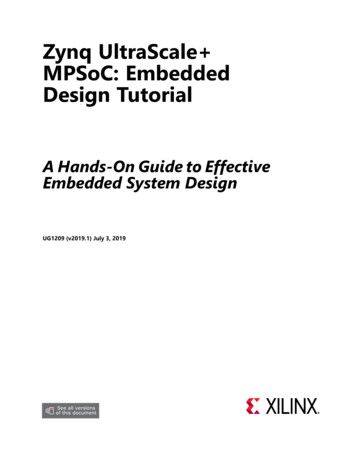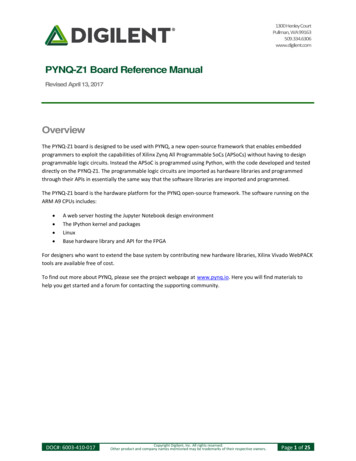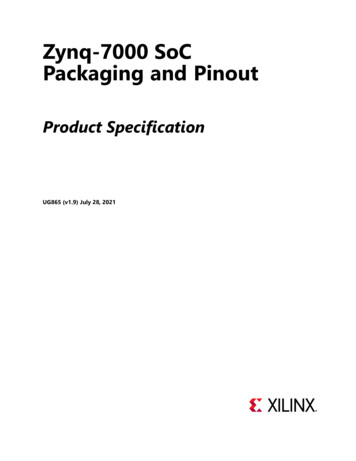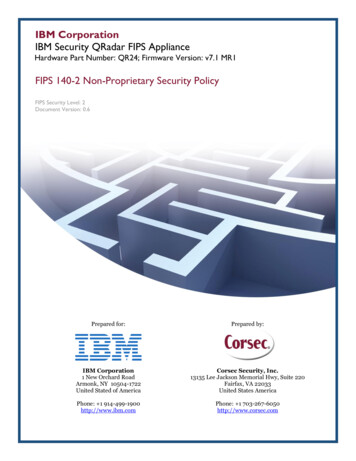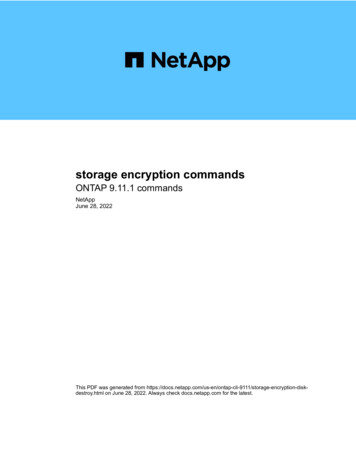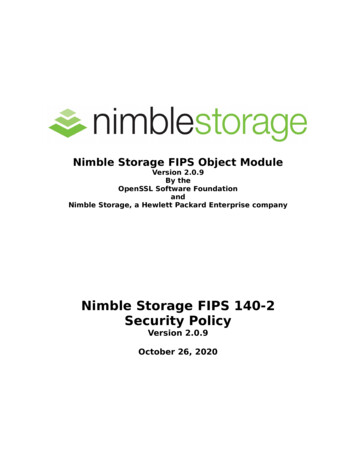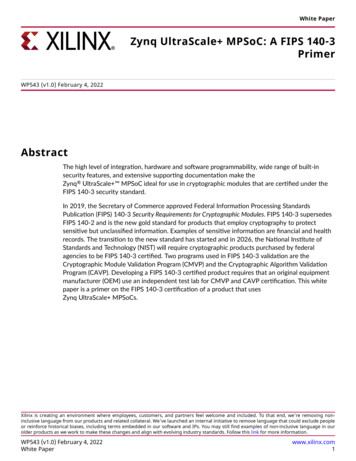
Transcription
White PaperZynq UltraScale MPSoC: A FIPS 140-3PrimerWP543 (v1.0) February 4, 2022AbstractThe high level of integration, hardware and software programmability, wide range of built-insecurity features, and extensive supporting documentation make theZynq UltraScale MPSoC ideal for use in cryptographic modules that are certified under theFIPS 140-3 security standard.In 2019, the Secretary of Commerce approved Federal Information Processing StandardsPublication (FIPS) 140-3 Security Requirements for Cryptographic Modules. FIPS 140-3 supersedesFIPS 140-2 and is the new gold standard for products that employ cryptography to protectsensitive but unclassified information. Examples of sensitive information are financial and healthrecords. The transition to the new standard has started and in 2026, the National Institute ofStandards and Technology (NIST) will require cryptographic products purchased by federalagencies to be FIPS 140-3 certified. Two programs used in FIPS 140-3 validation are theCryptographic Module Validation Program (CMVP) and the Cryptographic Algorithm ValidationProgram (CAVP). Developing a FIPS 140-3 certified product requires that an original equipmentmanufacturer (OEM) use an independent test lab for CMVP and CAVP certification. This whitepaper is a primer on the FIPS 140-3 certification of a product that usesZynq UltraScale MPSoCs.Xilinx is creating an environment where employees, customers, and partners feel welcome and included. To that end, we’re removing noninclusive language from our products and related collateral. We’ve launched an internal initiative to remove language that could exclude peopleor reinforce historical biases, including terms embedded in our software and IPs. You may still find examples of non-inclusive language in ourolder products as we work to make these changes and align with evolving industry standards. Follow this link for more information.WP543 (v1.0) February 4, 2022White Paperwww.xilinx.com1
Zynq UltraScale MPSoC: A FIPS 140-3 PrimerIntroductionThe NIST Computer Security Division and the Communications Security Establishment Canada(CSEC) administer the CMVP. A FIPS 140-3 certified product usually consists of hardware andsoftware/firmware included in an enclosure. Typically, an OEM integrates hardware andsoftware/firmware cryptographic modules into the top-level cryptographic module, which thencomprises the end product in an enclosure. Cryptographic modules use FIPS 140-3 approvedalgorithms, such as the advanced encryption standards (AES) or the Rivest Shamir Adleman (RSA)algorithm. The approved algorithm is certified in the CAVP.In March 2019, the United States Department of Commerce approved the FIPS140-3 SecurityRequirements for Cryptographic Modules [REF 1] to succeed FIPS140-2 [REF 2]. FIPS140-3represents the formal adoption of the International Organization for Standardization/International Electrotechnical Commission (ISO/IEC) 19790:2012/Cor 1:2015 standard toreplace FIPS 140-2. The ISO 24759:2017 standard serves as the derived testing requirementsand the NIST Special Publication (SP) 800-140A-F series serves as the requirements for theCMVP. Clarifications and guidelines to the ISO are provided in the Implementation Guidance forFIPS 140-3 and the Cryptographic Module Validation Program [REF 3].Vendors and OEMs obtain CAVP and CMVP certification using independent Cryptographic andSecurity Testing (CST) labs. The labs are accredited by the National Voluntary LaboratoryAccreditation Program (NVLAP). The CMVP FIPS certification process typically takes 9–12months. The certification process is expedited if the final cryptographic product consists ofcertified cryptographic algorithms and cryptographic modules. When a FIPS 140-3 certifiedalgorithm is used in a cryptographic module, the OEM must make the case to the CST that thecertified algorithm/module used is not modified.The Zynq UltraScale MPSoC Security section describes security in Zynq UltraScale MPSoCs.FIPS 140-3 provides security requirements in areas such as cryptographic boundary,cryptographic ports, software/firmware security, physical security, key management roles, selftest, and services. In many cases, the FIPS 140-3 security requirement is in the domain of theOEM's top-level cryptographic module. The Zynq UltraScale MPSoC security functionality canbe used to meet most of the module cryptographic requirements. However, additionalprotections (e.g., anti-tamper coatings) might be required outside of the Zynq device for module/system level certification.The CMVP Overview section describes the four levels of security defined in FIPS 140-3. It alsoprovides details on the Zynq UltraScale MPSoC’s functionality as it applies to the FIPS 140-3security requirements. The CAVP Overview provides background information on the CAVP andshows certified cryptographic algorithms used in Xilinx FPGAs and in theZynq UltraScale MPSoC.Zynq UltraScale MPSoC SecurityBuilt on TSMCs 16FinFET Plus (16FF ) process, the Zynq UltraScale MPSoC integrates Xilinxprogrammable logic (PL) and an Arm -based processing system (PS) that includes an applicationprocessing unit containing two or four Cortex -A53 cores (APU subsystem) and a real-timeprocessing unit containing two Cortex-R5F cores (RPU) in a single device.WP543 (v1.0) February 4, 2022White PaperSend Feedbackwww.xilinx.com2
Zynq UltraScale MPSoC: A FIPS 140-3 PrimerThe Zynq UltraScale MPSoC provides a number of features to help secure not only thehardware but the software applications running on it. These features include a hardened physicalunclonable function (PUF), user-accessible hardened cryptographic blocks, asymmetricauthentication, side-channel attack protection, and other silicon-based anti-tamper protections.See Accelerating Cryptographic Performance on the Zynq UltraScale MPSoC (WP512) andDeveloping Tamper-Resistant Designs with Zynq UltraScale Devices (XAPP1323) for details. Xilinxalso offers an intellectual property (IP) known as Security Monitor (SecMon) to provide runtimeprotection against a variety of tamper attacks. [REF 7].Xilinx classifies the security features as either passive or active. In general, passive features areeither part of the tool flow or built into the device and do not require you to do anything extra inyour SoC design. Passive features are also temporal in nature and come into effect at thefollowing phases of the operating life of the Zynq UltraScale MPSoC: Pre-boot During boot Post-bootIn contrast, active security features are required to be included in the SoC design. These featuresonly come into effect after the Zynq UltraScale MPSoC has been securely booted and thedesign becomes active. The security features fall into three main categories: Prevention (e.g., JTAG port disabling) Detection (e.g., on-chip temperature and voltage monitoring) Response (e.g., key zeroization)The following table summarizes the security features of the Zynq UltraScale MPSoC (seeDeveloping Tamper-Resistant Designs with Zynq UltraScale Devices (XAPP1323)).Table 1: Zynq UltraScale MPSoC Built-in Security FeaturesZynq UltraScale MPSoC Security FeaturesTypeCategoryImage/bitstream confidentiality (symmetric)PassivePreventionVolatile on-chip 256-bit BBRAM AES key storagePassivePreventionNon-volatile on-chip 256-bit eFUSE AES key storagePassivePreventionPUF-enabled black key storage (internal eFUSEs)PassivePreventionWrite-only key load with integrity check (BBRAM and eFUSE)PassivePreventionImage/bitstream authentication (symmetric)PassivePreventionImage/bitstream authentication (asymmetric)PassivePreventionNon-volatile 384-bit eFUSE public key hash storage to enable RSAauthenticationPassivePreventionDPA side-channel attack protectionsPassivePreventionObfuscation of the user AES key loading and storagePassivePreventionHardened readback disabling circuitryPassivePreventionDesign for test (DFT) boot mode permanent disablePassivePreventionUninterruptible internal clock source for CSUPassivePreventionError correction code (ECC) on PS memoriesPassivePreventionWP543 (v1.0) February 4, 2022White PaperSend Feedbackwww.xilinx.com3
Zynq UltraScale MPSoC: A FIPS 140-3 PrimerTable 1: Zynq UltraScale MPSoC Built-in Security Features (cont'd)Zynq UltraScale MPSoC Security FeaturesTriple-mode redundancy (TMR) in PS critical operationsJTAG port permanent disable ion or responseor activeJTAG port temporary disablePassivePreventionor activeJTAG port monitorActiveDetectionPL configuration memory integrity checkingActiveDetectionUnique identifiers (device DNA and user eFUSE)ActiveDetectionOn-chip temperature and voltage monitors/alarmsActiveDetection and responsePL configuration memory clearingActiveResponseUninterruptible internal clock source on PL STARTUP blockActiveDetectionKey agility (BBRAM only)ActivePrevention and responseBBRAM key zeroize (erase verify)ActiveResponseCSU tamper monitor and responseActiveDetection and responsePublic key revocationActiveResponseNon-volatile (eFUSE) tamper event loggingActiveResponseUser accessible crypto blocksActivePreventionArm TrustZoneActivePrevention and detectionArm v8 cryptography extensionsActivePrevention and detectionXilinx memory protection unit (XMPU)ActivePrevention and detectionXilinx peripheral protection unit (XPPU)ActivePrevention and detectionAXI/APB isolation block (AIB)ActivePrevention and responseAXI timeout block (ATB) in interconnectsActiveDetection and responseSystem memory management unit (SMMU)ActivePrevention and detectionGlobal 3-state (GTS) enable (PL I/O only)ActiveResponseGlobal set-reset (GSR) enable (PL I/O only)ActiveResponseAt the center of the device security is the hardened configuration security unit (CSU), shown inthe following figure. The CSU consists of two main blocks, the secure processor block (SPB) andthe crypto interface block (CIB), shown on the left and right of the figure, respectively. The SPBcontains a triple-redundant MicroBlaze processor for controlling boot operation, an associatedROM, a small private RAM, a PUF, and the necessary control/status registers required to supportall secure operations. The CIB contains engines for supporting and accelerating the followingcryptographic operations: AES-GCM, SHA-3, and RSA Direct memory access (DMA) controller Processor configuration access port (PCAP) interfaceWP543 (v1.0) February 4, 2022White PaperSend Feedbackwww.xilinx.com4
Zynq UltraScale MPSoC: A FIPS 140-3 PrimerFigure 1: Configuration Security Unit Block DiagramTo/From LPD Main SwitchCSU PMU SwitchCSU DMATamperSourcesINTCCSU tersPUFRSAMultiplierSecure Stream SwitchECCSHA-3384CSU ROMValidationRAM(32 KB)ROM(128 KB)Security Processor BlockAESGCM256PCAPTo PLConfigurationKeyManagementPMU ROMValidationBBRAMeFUSEPUFOperationKUPFamilyCrypto Interface BlockX26111-010722The CSU ensures the secure boot of the device by supporting the authentication andconfidentiality of the partitions in the boot image. This also includes the secure storage andmanagement of the cryptographic keys. After boot, the CSU is used for tamper monitoring andresponse of the device. At runtime, the crypto engines of the CSU can also be used by PS/PLapplications to accelerate cryptographic operations. Access to the CSU can be restricted tospecific applications with the XPPU.The following figure illustrates a typical Zynq UltraScale MPSoC boot process that builds a chainof trust to ensure a secure boot process so that security at runtime (application execution) can beachieved. The chain of trust is maintained assuming each loaded component is either immutable(for example, boot ROM code) or is properly authenticated.WP543 (v1.0) February 4, 2022White PaperSend Feedbackwww.xilinx.com5
Zynq UltraScale MPSoC: A FIPS 140-3 PrimerFigure 2: Secure Boot Chain of X26112-020122Secure boot is defined as authenticating PS/PL images (use of encryption is optional unlessconfidentiality is required for boot products). Image authentication (using RSA) ensures that animage came from a trusted source and has not been modified. The Zynq UltraScale MPSoCbuilds the chain of trust by supporting the authentication of the very first piece of user code thatis loaded on the SoC, which is the first stage boot loader (FSBL). To this end, the device alsochecks the integrity of the immutable boot ROM code (using SHA-3), which brings up the FSBL.Along with integrity and authentication, the Zynq UltraScale MPSoC also providesconfidentiality of the images (using AES-GCM) to protect against attacks such as cloning, overbuilding, and reverse engineering. There are a number of other security features such as blackkey storage and side-channel attack countermeasures that add to the robustness of the ZynqUltraScale device secure boot process.Unlike previous generations, the Zynq UltraScale MPSoC provides a PUF. The PUF, among otherfunctions, serves as a generator of a die-unique AES key-encryption key (KEK) that can be usedto encrypt/decrypt the symmetric 256-bit AES key that decrypts the partitions of the bootimage. That is, the Zynq UltraScale MPSoC encrypts the symmetric AES key using the KEK tofurther protect it, before storing it in non-volatile eFUSEs. Furthermore, the device stores the384-bit SHA-3 hash of the user-defined 4096-bit RSA public key in the eFUSE bits. Thisunmodifiable SHA-3 hash links the RSA public key to the device to enable authentication of theFSBL to establish a root-of-trust. User-defined cryptographic keys (AES keys and the hashes ofRSA keys) can be stored in the on-chip eFUSEs or battery-backed RAM (BBRAM). Theprogramming of BBRAM and eFUSEs is achieved using software that runs on the PS, which usesthe Xilinx Secure Key (XilSKey) library (see Zynq UltraScale MPSoC: Software Developers Guide(UG1137)).Arm TrustZone combined with XPPU and XMPU provides a system approach to security byisolating secure applications from non-secure applications, preventing access to or corruption ofthe secure applications. TrustZone is integrated into the Zynq UltraScale MPSoC Arm CortexA53 processors, extending to the PS and PL using the AXI bus. TrustZone defines secure worldand normal world for a trusted execution environment and a rich operating system. For moredetails, see Isolate Security-Critical Applications on Zynq UltraScale Devices (WP516). TrustZonecan be used for isolation and access control. Access control is a focus of the cryptographicmodule security policy, which is a security requirement described in CMVP Overview.WP543 (v1.0) February 4, 2022White PaperSend Feedbackwww.xilinx.com6
Zynq UltraScale MPSoC: A FIPS 140-3 PrimerAs an additional layer of runtime tamper protection, the Xilinx SecMon IP [REF 7] can beimplemented in Zynq UltraScale MPSoCs to provide runtime protection against a variety oftamper attacks. SecMon provides clock, JTAG port, voltage, temperature, and configurationmonitoring, and generates alarms if out-of-bounds activity is detected (SecMon IP also blocks theJTAG port). SecMon can respond to tamper detection by performing functions such as BBRAMkey zeroization and zeroization of the device. SecMon can also take tamper input from externalelements to provide a centralized system-level tamper detection and system response.The isolation design flow (IDF) (see Isolation Design Flow for UltraScale FPGAs and Zynq UltraScale MPSoCs (XAPP1335)) is supported for static and reconfigurable PL applications with ZynqUltraScale MPSoCs. The IDF methodology allows the designer to logically isolate the securefrom the non-secure functions implemented in the PL.CMVP OverviewThe participants in a FIPS 140-3 certification process are the semiconductor vendor, the CST, theCMVP/CAVP authority, and the OEM. Most of the tasks in CMVP/CAVP certification areperformed by the vendor (or OEM) and the CST. The OEM produces the end product, which typically integrates multiple cryptographicmodules in an enclosure. The vendors are companies such as Xilinx, QNX, Green Hills, and Wind River. There are twelve CST labs in the U.S. and twenty-one worldwide.FIPS 140-3 certification requires extensive documentation. Certification starts with the OEMselecting a CST laboratory and providing the documentation described in the standard. Becausethe Zynq UltraScale MPSoC has a very large number of users, most of the documentation isavailable. The availability of cost-optimized Zynq UltraScale MPSoC evaluation boards allowsalmost immediate testing of hardware and software relative to a large cryptographic boundary.The testing can be done at the CST facility or by the vendor.FIPS 140-3 specifies a wide spectrum of requirements a cryptographic module must meet toaddress a diversity of application environments. The requirements are categorized into elevendistinct requirement areas/sections, and for each section, the standard defines four securitylevels that gradually enhance the security mechanisms of the module. Most of the securityrequirements can be tested to a specified security level. The principle drivers defining thedifferent security levels are the operating system and the anti-tamper (AT) requirements. Theoverall FIPS 140-3 certification level is the lowest level attained in all of the securityrequirements. Most FIPS 140-3 certifications are to security levels 1 and 2, which are describedbelow.Compared to FIPS 140-2, FIPS 140-3 defines the same sections of security requirements as itspredecessor with the following exceptions: The Electromagnetic Interference/Electromagnetic Compatibility (EMI/EMC) section in FIPS140-2 has been removed from FIPS 140-3. The Finite State Model section of FIPS 140-2 becomes a subsection and part of the Life-cycleAssurance section of FIPS 140-3.WP543 (v1.0) February 4, 2022White PaperSend Feedbackwww.xilinx.com7
Zynq UltraScale MPSoC: A FIPS 140-3 Primer FIPS 140-3 introduces two sections to the standard, the Software/Firmware Security and Noninvasive Security sections, by grouping related requirements already existing in FIPS 140-2 andspecifying new ones. The FIPS 140-2 Cryptographic Key Management and Design Assurance sections have beenrenamed in FIPS 140-3 as Sensitive Security Parameter Management and Life-cycle Assurance,respectively.Another important change in FIPS 140-3 is the removal of all references to the Common Criteriafor Information Technology Security Evaluation (CC). CC is an international standard (ISO/IEC15408) for computer security certification and identifies and documents security requirementsbased on consumers' needs. CC defines seven Evaluation Assurance Levels (EALs) and unlike FIPS140-2, which includes EAL requirements in Security Levels 2 to 4, in FIPS 140-3 all thereferences to EALs have been removed.The four security levels of FIPS 140-3 are summarized as follows. Security Level 1 (SL1): Is the lowest FIPS 140-3 level defined and specifies the basic securityrequirements for a cryptographic module. There are no requirements for authentication norfor physical security in SL1 and, consequently, it is appropriate for modules that are to bedeployed in an environment that already provides these security features. Security Level 2 (SL2): Adds on to SL1 by including requirements for minimum role-basedauthentication and protection against tamper attacks. This allows cryptographic modules to bedeployed in modifiable environments capable of supporting role-based access. Tamperprotection involves the use of tamper-evident coatings or seals or pick-resistant locks onremovable covers or doors. Security Level 3 (SL3): Enhances further the mechanisms SL2 specifies for protection againstunauthorized access and includes additional requirements for non-invasive mitigationmethods and life-cycle assurances. It requires the use of strong enclosures and tamperdetection/response circuitry (e.g., zeroization of all the sensitive security parameters (SSPs)).SL3 also takes authentication up a level, by requiring identity-based authentication.Furthermore, at SL3, all cryptographic modules should include features for environmentalfailure protection (EFP) or undergo rigorous environmental failure testing (EFT). Security Level 4 (SL4): Is the highest FIPS 140-3 level and includes all the security features thelower levels specify, as well as extended features. Indicatively, SL4 introduces multi-factoridentity-based authentication for all services that use trusted channels. Furthermore, SL4certified cryptographic modules with SSPs should be able to detect and respond to allunauthorized attempts at physical access. Also, at SL4, the modules are required to includeEFP and special environmental protection features to ensure that security is not compromisedwhen they are forced to operate outside of their normal operating range. SL4 is appropriatefor modules that are to be deployed in physically unprotected environments.FIPS 140-3 Requirement SectionsThis section summarizes the eleven FIPS 140-3 requirement sections and provides a high-levelexplanation of how the Zynq UltraScale MPSoC can be used to satisfy each.WP543 (v1.0) February 4, 2022White PaperSend Feedbackwww.xilinx.com8
Zynq UltraScale MPSoC: A FIPS 140-3 PrimerCryptographic Module SpecificationThis section specifies the requirements for the proper definition of the cryptographic modulealong with approved algorithms, modes of operation, and security policy. A cryptographic moduleis defined with one of the following module types: Hardware Software Firmware Hybrid software Hybrid firmwareThe two hybrids are modules that are composed of either a software or firmware component anda disjoint hardware component (that is, the software/firmware component is not containedwithin the hardware component). Furthermore, this clause specifies requirements for thecryptographic boundary. This boundary defines what is included and excluded, physical ports andlogical interfaces, and the control/status signals of modules. A FIPS-approved normal mode ofoperation of the module should use at least one service that employs an approved securityfunction specified in the standard.Note: Non-security-relevant functions and components can be included within the cryptographic boundaryand used in an approved normal mode of operation, provided that they do not compromise the security ofthe module.To help troubleshoot potential issues, FIPS 140-3 also introduces the degraded mode ofoperation in addition to the normal mode as specified in FIPS 140-2. Upon entering an approveddegraded mode of operation, the module is allowed to operate even if it can only offer a subsetof its functions due to an error that has occurred. The module is allowed to enter the degradedoperation mode only if it successfully passes all pre-operational self-tests (see requirements inSelf-tests).The following Zynq UltraScale MPSoC attributes facilitate the creation of this specification in atimely manner: Built-in isolation mechanisms to provide the implemented functions with a well-defined,hardware-enforced cryptographic boundary. A hardware rooted chain of trust to ensure the secure boot of the system. A hardened unit (CSU) dedicated to implementing the SHA-3, RSA, and AES-GCMcryptographic algorithms that are FIPS-approved and have passed CAVP. The hardware and software programmability allows for additional FIPS-approved algorithms,bypass/non-FIPS modes, etc.WP543 (v1.0) February 4, 2022White PaperSend Feedbackwww.xilinx.com9
Zynq UltraScale MPSoC: A FIPS 140-3 Primer Extensive documentation (Developing Tamper-Resistant Designs with Zynq UltraScale Devices(XAPP1323), Isolation Design Flow for UltraScale FPGAs and Zynq UltraScale MPSoCs(XAPP1335), Isolation Methods in Zynq UltraScale MPSoCs (XAPP1320), External Secure StorageUsing the PUF v1.0 Application Note (XAPP1333), and Zynq UltraScale Device TechnicalReference Manual (UG1085)) can provide additional information on how to use the device'sfeatures to isolate security functions, develop tamper-resistant designs, generatecryptographic keys, etc.Cryptographic Module InterfacesThe cryptographic module should have the following logical interfaces specified in FIPS 140-2plus a Control output interface introduced in FIPS 140-3. Data input Data output Control input Status output Control output (introduced in FIPS 140-3)The addition of the control output interface aims to enable the exchange of commands amongmodules. All non-software modules should also have a power interface if power is not managedwithin the cryptographic boundary. Furthermore, FIPS 140-3 introduces the concept of trustedchannels (similar to the trusted paths specified in FIPS 140-2) to specify the secure exchange ofplaintext critical security parameters (CSPs) among modules. For SLs 1 and 2, there are norequirements for the use of trusted channels. However, for SLs 3 and 4, the exchange of plaintextCSPs requires the use of trusted channels. The trusted channels should have either their physicalports physically separated from all other ports or their logical interfaces logically separated fromall other interfaces. Depending on the security level (SL3 or SL4), there are specific requirementsfor authentication of all the services that use the trusted channel and for its protection againsteavesdropping and physical/logical tampering.The designer of the cryptographic module is responsible for the implementation of the requestedports and for the interfaces that are used for transferring keys to and from the device. TheZynq UltraScale MPSoC is composed of four major power domains. Three of the powerdomains provide power to the PS and the fourth is used to power the device's PL, which isknown as the PL power domain (PLPD). Consequently, PL-only modules can be isolated from PSbased applications post-boot. If the designer opts to repurpose the hardened cryptographicengines of the CSU (see Figure 1), the module can take advantage of theZynq UltraScale MPSoC's security features. Data from the PS/PL are DMA'ed to the CSU andthen distributed to the appropriate cryptographic engine using the CSU's secure stream switch.Cryptographic keys can be updated at runtime using the CSU's key management facility. Asdiscussed in Zynq UltraScale MPSoC Security, access to the engines can be hardware-controlledusing the XPPUs. Furthermore, the CSU along with the RPU and the platform managementsystems are powered by the same domain (low-power domain) and, consequently, the modulecan be power-isolated from the PL and the rest of the PS system.WP543 (v1.0) February 4, 2022White PaperSend Feedbackwww.xilinx.com10
Zynq UltraScale MPSoC: A FIPS 140-3 PrimerRoles, Services, and AuthenticationThe cryptographic module should be able to support distinct roles for its operators and thecorresponding services the latter can access. In particular, the module should support at aminimum a crypto officer role and, optionally, a user role and a maintenance role. In FIPS 140-2,only the maintenance role is optional. There are no authentication requirements for SL1 modules.At SLs 2 and 3, the module should employ role-based authentication and identity-basedauthentication, respectively. At SL4, the clause adds an additional layer of security by requestingthe modules to employ multi-factor identity-based authentication. Also, the module shouldexpose the following services to operators: Module version and status Security functions Zeroization Self-testFIPS 140-3 also introduces requirements for module self-initiated security functions that requireno operator intervention at runtime. The requirements of this clause also cover the secureloading of software/firmware from an external source to the module.Bootgen (see Bootgen User Guide (UG1283)), the Xilinx image generation tool, supports avariation on the split knowledge referenced in FIPS 140-3. For example, the encryption andauthentication can be done on different servers by different operators by using Bootgen in thehardware security monitor (HSM) mode. The Zynq UltraScale MPSoC provides RSA asymmetricauthentication, starting with the FSBL and including all partitions loaded into the embeddedsystem. Bootgen supports a user-defined field (UDF) in the authentication certificate for identityauthentication on the partitions loaded. If the UDF is used, the user must modify the FSBL toimplement the identity check. Also, authenticated application code residing on the PS canimplement role-based/user-based authentication schemes. Runtime device health checks, tamperresponse involving auto-triggered SSPs zeroization, and SoC lockdown are also part of the selfinitiated security functions the Zynq UltraScale MPSoC provides to the operator.Software/Firmware SecurityFIPS 140-3 introduces this new section of requirements by grouping all the software/firmwarerequirements for integrity and loading of tests that are in FIPS 140-2. The section also introducesa few new requirements and allowances. At all security levels, integrity tests should be applied toa software/firmware module either by the module itself or by another validated and approvedmodule. The tests should be able to be triggered using only interfaces specified in the standard,and all temporary values generated during a test should be zeroized upon completion of the test.Error correction codes (at minimum 16-bit in length) are still acceptable but only at SL1 and onlyfor software/firmware components within a hardware module or within a disjoint hardwarecomponent of a hybrid module. For software/firmware modules at SL1, the only acceptableWP543 (v1.0) February 4, 2022White PaperSend Feedbackwww.xilinx.com11
Zynq UltraScale MPSoC: A FIPS 140-3 Primerintegrity methods are based on either message authentication codes (MACs) or digital signatures.At SL2, using hash-based MACs (HMACs) or digital signatures is mandato
paper is a primer on the FIPS 140-3 certification of a product that uses Zynq UltraScale MPSoCs. W h i t e P a p e r . or reinforce historical biases, including terms embedded in our software and IPs. You may still find examples of non-inclusive language in our older products as we work to make these changes and align with evolving industry .

